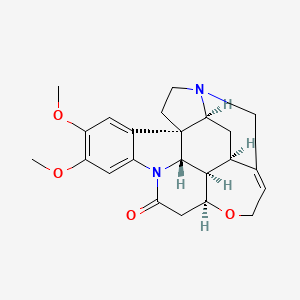Ferroptosis-centered Drug Response Information
General Information of the Drug (ID: ferrodrug0028)
| Name |
Brucine
|
||||
|---|---|---|---|---|---|
| Synonyms |
BRUCINE; 357-57-3; 10,11-Dimethoxystrychnine; Brucinum; 2,3-Dimethoxystrychnine; (-)-Brucine; l-Brucine; 2,3-Dimethoxystrychnidin-10-one; Strychnidin-10-one, 2,3-dimethoxy-; 10,11-Dimethystrychnine; Brucine, Anhydrous; Brucina; Brucin; 6NG17YCK6H; Brucine alkaloid; CHEBI:3193; DTXSID2024662; Dimethoxy strychnine; Brucine hydrate; NSC-757797; Bruzin; 2,3-Dimethoxy-strychnine; RCRA waste number P018; Strychnine, 2,3-dimethoxy-; DTXCID204662; 145428-94-0; Brucin [German]; Brucina [Italian]; CAS-357-57-3; SMR000112281; 63428-84-2; 5892-11-5; UNII-6NG17YCK6H; 10,11-dimethoxy strychnine; CCRIS 4754; HSDB 307; anhydrous brucine; Bisdesmethylbrucin; UN 1570; NCGC00094861-01; EINECS 206-614-7; UN1570; BRUCINE [VANDF]; BRUCINUM [HPUS]; BRUCINE [HSDB]; BRUCINE [MI]; RCRA waste no. P018; Brucine, anhydrous, 98%; BRUCINE [NFLIS-DRUG]; GTPL342; MLS000515808; MLS001424166; SCHEMBL113229; CHEMBL501756; MEGxp0_001865; ACon1_001990; Brucine [UN1570] [Poison]; RRKTZKIUPZVBMF-IBTVXLQLSA-N; HMS2052O03; HMS2268L16; Tox21_111349; Tox21_302174; BDBM50401037; AKOS015955678; AKOS024282466; CCG-101078; NC00328; NSC 757797; NCGC00255253-01; NCGC00263445-02; NCGC00384497-01; B0670; B0946; C09084; Q411022; SR-01000712407; Q-100426; SR-01000712407-5; BRD-K68077509-001-01-6; Brucine, European Pharmacopoeia (EP) Reference Standard; (1R,11S,18S,20R,21R,22S)-4,5-dimethoxy-12-oxa-8,17-diazaheptacyclo[15.5.2.0^{1,18}.0^{2,7}.0^{8,22}.0^{11,21}.0^{15,20}]tetracosa-2(7),3,5,14-tetraen-9-one
Click to Show/Hide
|
||||
| Status |
Investigative
|
||||
| Drug Type |
Small molecular drug
|
||||
| Structure |
 |
||||
| Formula |
C23H26N2O4
|
||||
| IUPAC Name |
(4aR,5aS,8aR,13aS,15aS,15bR)-10,11-dimethoxy-4a,5,5a,7,8,13a,15,15a,15b,16-decahydro-2H-4,6-methanoindolo[3,2,1-ij]oxepino[2,3,4-de]pyrrolo[2,3-h]quinolin-14-one
|
||||
| Canonical SMILES |
COC1=C(C=C2C(=C1)C34CCN5C3CC6C7C4N2C(=O)CC7OCC=C6C5)OC
|
||||
| InChI |
InChI=1S/C23H26N2O4/c1-27-16-8-14-15(9-17(16)28-2)25-20(26)10-18-21-13-7-19-23(14,22(21)25)4-5-24(19)11-12(13)3-6-29-18/h3,8-9,13,18-19,21-22H,4-7,10-11H2,1-2H3/t13-,18-,19-,21-,22-,23+/m0/s1
|
||||
| InChIKey |
RRKTZKIUPZVBMF-IBTVXLQLSA-N
|
||||
| PubChem CID | |||||
| TTD Drug ID | |||||
Full List of Ferroptosis Target Related to This Drug
NADPH oxidase 4 (NOX4)
| In total 1 item(s) under this Target | |||||
| Experiment 1 Reporting the Ferroptosis-centered Drug Act on This Target | [1] | ||||
| Target for Ferroptosis | Driver | ||||
| Responsed Disease | Glioblastoma | ICD-11: 2A00 | |||
| Responsed Regulator | Cyclic AMP-dependent transcription factor ATF-3 (ATF3) | Driver | |||
| Pathway Response | Fatty acid metabolism | hsa01212 | |||
| Ferroptosis | hsa04216 | ||||
| Cell Process | Cell ferroptosis | ||||
| Cell proliferation | |||||
| In Vitro Model | U118 cells | Astrocytoma | Homo sapiens | CVCL_0633 | |
| U87 MG-Red-Fluc cells | Glioblastoma | Homo sapiens | CVCL_5J12 | ||
| U-251MG cells | Astrocytoma | Homo sapiens | CVCL_0021 | ||
| A-172 cells | Glioblastoma | Homo sapiens | CVCL_0131 | ||
| In Vivo Model |
The athymic BALB/c nude mice (4 weeks; 20-22 g; Beijing Vital River Laboratory Animal Technology Company, China) were housed in a specific pathogen-free environment under a 12-h lightdark cycle with free access to food and water. The animals were allowed to acclimatize to their surroundings for 3 days. U87 cells (1 x 106) in the logarithmic growth phase in 100 uL PBS were subcutaneously injected into the right flank. Therapeutic experiments were started when the tumor reached around 150 mm3 after about 10 days. Mice were allocated to receive intraperitoneal injections of vehicle (control group, n = 6) or 40 mg/kg bodyweight (n = 6) in the same volume (50 uL) once a day for 13 times.
Click to Show/Hide
|
||||
| Response regulation | Brucine inhibited glioma cell growth in vitro and in vivo, and brucine induced ATF3 upregulation and translocation into nuclei via activation of ER stress. ATF3 promoted brucine-induced H2O2 accumulation via upregulating NOX4 and SOD1 to generate H2O2 on one hand, and downregulating catalase and xCT to prevent H2O2 degradation on the other hand. | ||||
Cystine/glutamate transporter (SLC7A11)
| In total 1 item(s) under this Target | |||||
| Experiment 1 Reporting the Ferroptosis-centered Drug Act on This Target | [1] | ||||
| Target for Ferroptosis | Suppressor | ||||
| Responsed Disease | Glioblastoma | ICD-11: 2A00 | |||
| Responsed Regulator | Cyclic AMP-dependent transcription factor ATF-3 (ATF3) | Driver | |||
| Pathway Response | Fatty acid metabolism | hsa01212 | |||
| Ferroptosis | hsa04216 | ||||
| Cell Process | Cell ferroptosis | ||||
| Cell proliferation | |||||
| In Vitro Model | U118 cells | Astrocytoma | Homo sapiens | CVCL_0633 | |
| U87 MG-Red-Fluc cells | Glioblastoma | Homo sapiens | CVCL_5J12 | ||
| U-251MG cells | Astrocytoma | Homo sapiens | CVCL_0021 | ||
| A-172 cells | Glioblastoma | Homo sapiens | CVCL_0131 | ||
| In Vivo Model |
The athymic BALB/c nude mice (4 weeks; 20-22 g; Beijing Vital River Laboratory Animal Technology Company, China) were housed in a specific pathogen-free environment under a 12-h lightdark cycle with free access to food and water. The animals were allowed to acclimatize to their surroundings for 3 days. U87 cells (1 x 106) in the logarithmic growth phase in 100 uL PBS were subcutaneously injected into the right flank. Therapeutic experiments were started when the tumor reached around 150 mm3 after about 10 days. Mice were allocated to receive intraperitoneal injections of vehicle (control group, n = 6) or 40 mg/kg bodyweight (n = 6) in the same volume (50 uL) once a day for 13 times.
Click to Show/Hide
|
||||
| Response regulation | Brucine inhibited glioma cell growth in vitro and in vivo, and brucine induced ATF3 upregulation and translocation into nuclei via activation of ER stress. ATF3 promoted brucine-induced H2O2 accumulation via upregulating NOX4 and SOD1 to generate H2O2 on one hand, and downregulating catalase and xCT (SLC7A11) to prevent H2O2 degradation on the other hand. | ||||
